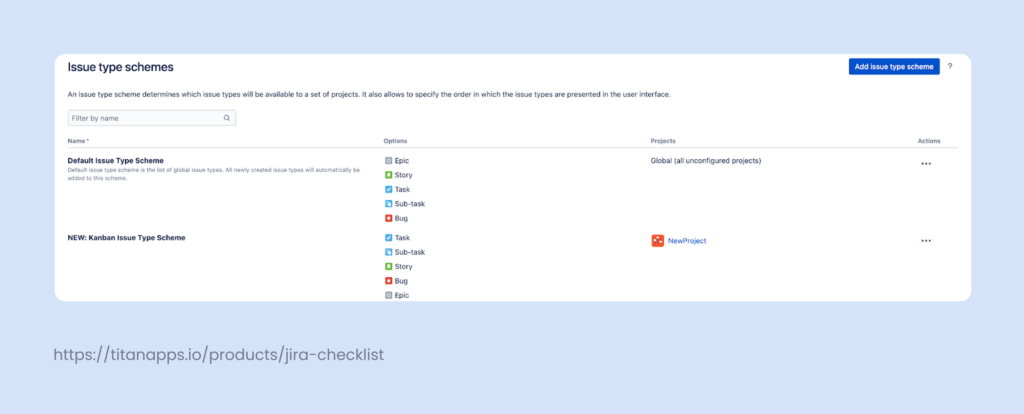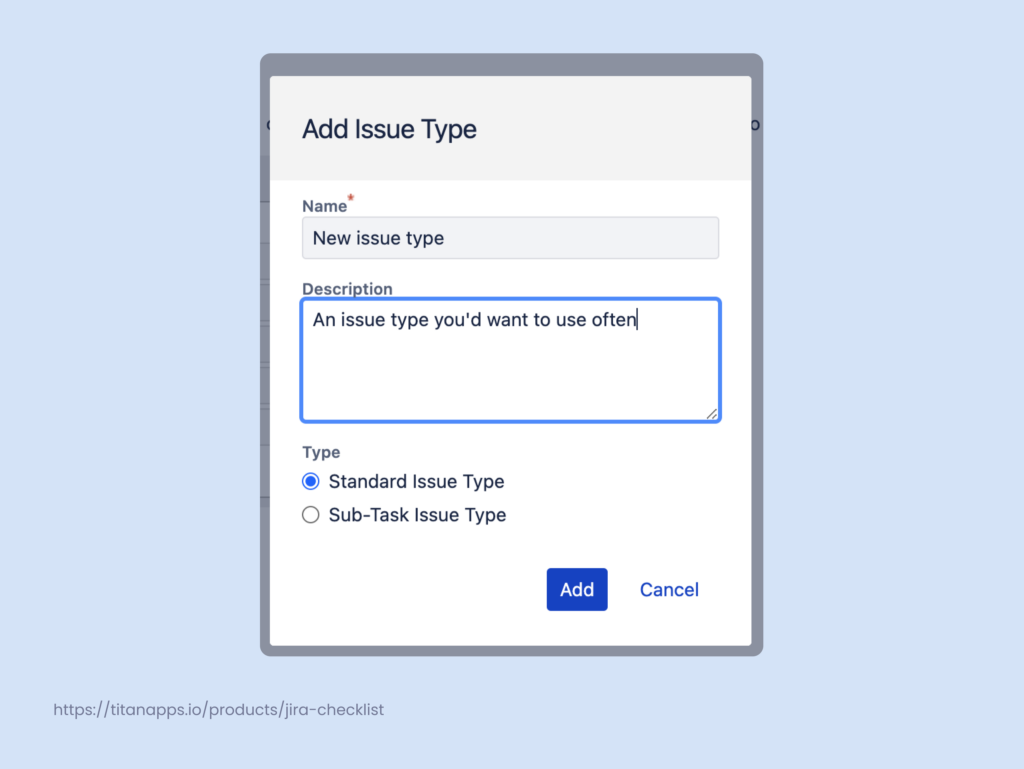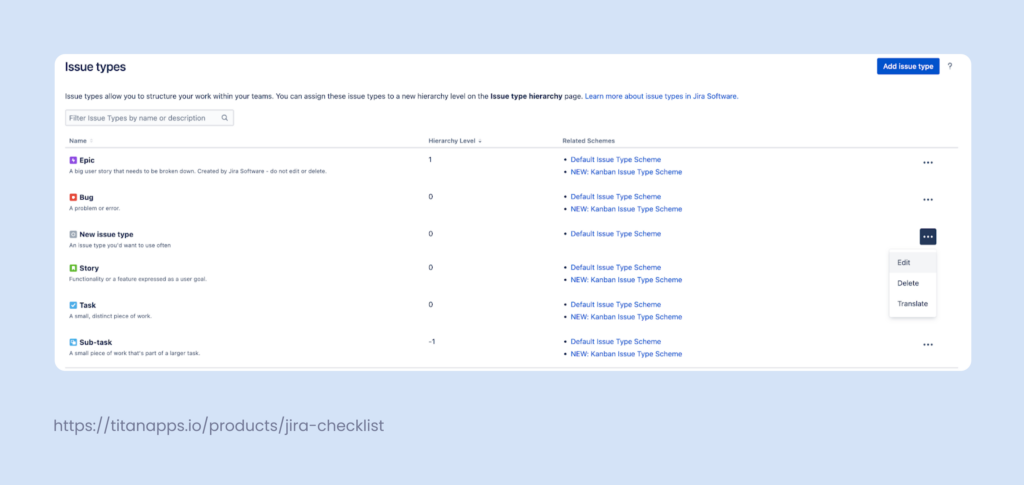JIRA brings more structure to the working process by utilizing such features as the search & sort, tracking, and the time taken to complete the task. However, most of this functionality requires systems that can diversify certain issues from others – issue types.
In this article, we’ll talk about the different issue types, their uses, and how to get the most out of them.
What are Issue Types in JIRA?
JIRA issue types are simply pre-defined templates that assist in categorizing and organizing your work. Think of them as JIRA templates for specific issues. They are designed to help track the type of work and the fields required to proceed with the work.
It is much easier to filter and sort through your work and track progress or even estimate how long it takes for a team to respond to something specific like a bug when you have several issue types.
Additionally, Jira Software provides access to workflows. Think of them as a path your issues take from creation to completion. These workflows comprise of a set of statuses through which the issues move during the lifecycle. You can use issue types to have specific workflows for selected issue types.
Parent and Child Issues
Parent and Child issues define the relationship between the issue types in JIRA.
A parent issue is an issue type that is above the child issues in JIRA. Conversely, a child issue is an issue that comes below the parent issue.
Let’s take an example of this issue hierarchy that has epic, tasks, user stories, sub-tasks, and bugs:
- An epic is a parent issue for stories, tasks, and bugs.
- Stories/tasks can be a parent issue for bugs and subtasks.
- A sub-task can only be a child issue as nothing is below it.
Jira Issue Types Explained
The classification and tracking of various categories, including bugs, tasks, and stories, are facilitated by issue types, which can be customized according to the project requirement. JIRA offers several predefined issues.
Epic
An Epic is an issue that breaks large, complex tasks into manageable pieces, such as user stories or tasks. The idea is to divide the large workload into manageable sections and assign them to the team members.
Epic divides the task into numerous sprints that span over some time.
Let’s say you have an eCommerce revamp project.
The whole scope can be broken down into several categories, such as:
- Improving UI
- Rewriting the content
- Updating the pricing plans
- Replacing the old images with a new image library and so on
The above categories can be referred to as the Epics in JIRA, whereas the smaller tasks below become stories.
While the Epics create the roadmaps for these projects, it does not represent an entire project.
Each of these epics can be assigned to different teams. For instance, improving the UI can be assigned to the UI experts, whereas the content team can look after the rewriting.
The teams can further divide the Epic into the user stories or tasks subsequently.
Story
User stories are written from the user’s perspective and are the smallest features within Epic. User stories define the project through short and simple descriptions in a conversational language.
A good example of a story is considering the feature that a customer will use to get value. For instance, a story can be written as a scenario that follows, “As a user, I want to find a payment button that is clearly transparent and provides a seamless experience.”
Task
A task in project management is a piece of work that needs to be done to complete a story. This includes tasks like research, validation, and implementation. A task can simply be a stepping stone for completing the story.
For example, if a user story is “completing the payment”, the task should then be embedding the link to the checkout page and integrating it with the payment gateway.
Bug
A bug is an issue that restricts the product’s functionalities and its ability to perform tasks. In agile software, bugs can be product issues or quality issues.
Bugs can be detected during the software testing, production, or even after the software has been released. After detection, the bugs are assigned to the developer team as a task.
Example: A bug can be a broken link or a dysfunctional button. When a user clicks on the button, they see an error or a broken web page.
Sub-task
Sub-task issue type falls into the lowest tier of the software development stage. A sub-task is a more manageable and small piece of work that arises by breaking down the user stories, epic, or tasks.
A sub-task is used to complete the tasks.
In a software development project, the team breaks down a feature implementation task into smaller, focused “SUBTASK” issues.
For example, one of these subtasks might be “Write an assignment” for quality check and develop features. In this SUBTASK, the team can focus on creating thorough assignments to validate functionality and maintain code quality.
Issue Type Schemes
Issue type Schemes in JIRA help group issue types. An issue type scheme makes it easier to align the issue types with project objectives and goals. It’s also useful if you would like to reuse certain selections of issue types in different projects.
It is worth noting that only one issue type scheme can be assigned to a project.
By using the issue type scheme for a project, the teams gain more transparency on what issue type can be used for a task.
Issue type schema will depend on the type of project that was selected. For example, Jira Software will have Epics, stories, and sub-tasks. Jira Ervice management, on the other hand, will have change, IT help, incident, new feature, problem, service request, service request with approval, and support issue types.
Default Issue Scheme
Simply said, the default issue type scheme includes all the issue types that are present in all the projects by default unless it is associated with other schemes.
Default issue type schemes include the following issue types by default: epic, story, and sub-task. When you create a new issue type, it will be automatically added to the default scheme type.
There are also a few things to know about the default scheme:
- A project with a unique issue type won’t automatically add to the default scheme
- You can’t delete a default issue type scheme

You can create a new issue type scheme with various issue types. This issue type scheme is not limited to certain issue types but can include unique issue types such as research, documentation, tasks, improvement, etc. With the specific issue types added to this scheme, the agile teams can seamlessly work, bringing task prioritization, sprint planning, and enhanced collaboration.
Similarly, there can be testing issue type schemes, modifying project scheme types, support schemes, and more.
Custom Issue Types In Jira: Use Cases And Real-Life Examples
While JIRA offers pre-defined issue types such as epic, tasks, and bugs, the teams may often require customization to align with their unique workflow and approach. The custom issue types bring more flexibility to the teams, resulting in better organization and greater clarity.
Let’s look at some use cases of JIRA custom issue types and how teams use them.
Questions
This custom issue type is used by the teams in JIRA to simply provide assistance through the questions and answers in teams, email, or comment. Simply said, a question issue type maps the impact on the task if the question is asked within the team or externally.
Take an example of a customer service team that does not need any ticket submission or customer support but needs a quick answer to the question. Such custom questions can improve the workflow and reduce the number of tickets.
Decisions
Teams use this custom issue type to track and manage the decision-tracking process in JIRA. This issue type can be vital in tracking the outcomes, reasoning, and deadlines on tasks.
Within the issue type scheme, this issue type maps dependency with other issue types and analyses the impact of these decisions on the project.
For example, a software development team can use this issue type to record the responses and later track the outcomes from the relevant stakeholders or team leaders and maintain a clear audit.
Technical Debt
Another custom issue type that is used by the technical teams is technical debt. This issue type highlights all the technical issues within the software to maintain the software and keep it technically sound. In fact, technical debt is a priority among the development teams.
Technical debt is not just detecting the bugs but also ensuring compliance with the regulations and keeping a check on the coding standards. Even a bug-free code can have technical debt within.
There are other additional custom issue types in JIRA that you might find useful:
- Feature Request: The custom issue types in JIRA to add new features, enhance functionality, and track feature requests from users and stakeholders.
- Test Case: Test cases are useful in testing out the new features, and it is associated with the user stories and epics.
- Change: This is a spearhead in IT project management where users and stakeholders need to track changes and approvals within the system.
- Support Requests: This issue type tracks the support requests from the users and customers. Support requests are vital in managing the tickets and ensuring that queries are responded to quickly and effeciently.
How To Create A Custom Issue Type In Jira?
First thing first, you need to be an administrator to add the new custom issue types. Here are the steps to follow:
- Head to the JIRA administration icon and choose “Issues”
- In the left column, click on “Issue Types” and then “Add Issue Type”
- Add the specific issue type name and description that best defines it
- Also, select whether this issue is a standard issue type or a sub-task issue type
- Click on “Add” to create the custom issue type

Technically, you have a new issue type that’s fully functional. I’d still suggest going one step further.
Go to your issue types, find the one you’ve just added, and click on the button with three dots to edit.

Click on select image under the Issue Type Avatar* option and pick a new avatar or even upload one from your computer. This will make differentiating between different issue types much simpler in the long run.
Conclusion
Each JIRA issue serves a different purpose for the different agile teams. These features are significant in improving the team’s efficiency and measuring the tasks in progress. JIRA admins can also assign or juggle multiple issue types such as epic, bugs, tasks, or sub-tasks.